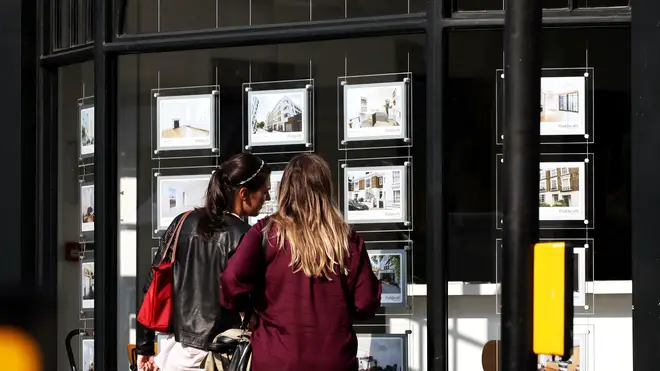
Henry Riley 4am - 7am
25 January 2021, 00:04

In London, the typical first-time buyer deposit ballooned by £20,000 in 2020 compared with 2019, reaching more than £130,000, Halifax said.
The average first-time buyer was required to put down £10,000 more last year as a deposit than if they had got on the property ladder in 2019, according to analysis.
In London, the typical first-time buyer deposit ballooned by £20,000 to more than £130,000, the research from Halifax found.
Across the UK, the average amount put down by a first-time buyer in 2020 was £57,278, compared with £46,449 the year before, marking a 23% increase, or £10,829 in cash terms.
Average deposits for first-time buyers in London were up by £20,211 (18%), from £110,145 to £130,357.
Other areas also saw big increases, with the average first-time buyer deposit growing by 25% (£6,634) in Wales, from £26,029 to £32,663.
Despite many low-deposit mortgages being pulled from the market in 2020 amid the coronavirus crisis, first-time buyers still made up half (50%) of home purchase loans last year, Halifax estimates, down from 51% in 2019.
The bank, which used UK Finance figures for part of its calculations, said the overall number of first-time buyers in 2020 was down by more than 46,000, or 13%, compared with 2019, with an estimated 304,657 first-time buyers in 2020.
This was the lowest number since 2015, when there were 298,080 first-time buyers.
Northern Ireland, Wales and Scotland were the parts of the UK with the biggest decreases in first-time buyers last year, while London experienced the smallest fall, Halifax found.
According to Office for National Statistics (ONS) figures, average UK house prices jumped to a record high of £250,000 in November and those in London broke through the £500,000 barrier for the first time.
The average UK house price was £250,000 in November 2020, up from £247,000 in October 2020.
This is £18,000 higher than the same period a year ago https://t.co/DPdue6OFOZ pic.twitter.com/ByxiOnOHOq
— Office for National Statistics (ONS) (@ONS) January 20, 2021
A temporary stamp duty holiday and pent-up demand after the market was put on hold in the early part of 2020 have fuelled demand, with rising prices making life harder for those trying to get on the property ladder.
Russell Galley, managing director, Halifax, said: “Whilst these figures confirm the almost inevitable fall in the overall number of first-time buyers in 2020 – with the entire housing market effectively shuttered during the first national lockdown – they also underline just how strong the bounceback was in the second half of the year.
“Despite the obvious challenges presented by soaring house prices, not least the need to raise an even bigger deposit, first-time buyers still accounted for half of all home purchases, a reassuring statistic given their overall importance to the market.
“However, with the economic impact of the pandemic likely to be felt most keenly by the young and those in lower-paid jobs, the need to prioritise improved housing availability and affordability for all those looking to make that first step on to the property ladder becomes ever greater.”
Here are average first-time buyer deposits in 2019 followed by 2020 and the increases in percentage and cash terms compared with 2019, according to Halifax:
– North East, £23,788, £29,563, 24%, £5,775
– Yorkshire and the Humber, £28,008, £33,313, 19%, £5,305
– North West, £29,519, £34,347, 16%, £4,829
– East Midlands, £33,268, £39,052, 17%, £5,783
– West Midlands, £34,008, £42,062, 24%, £8,054
– East Anglia, £43,474, £51,126, 18%, £7,652
– Wales, £26,029, £32,663, 25%, £6,634
– South West, £42,504, £51,397, 21%, £8,893
– South East, £54,654, £64,910, 19%, £10,256
– London, £110,145, £130,357, 18%, £20,211
– Northern Ireland, £25,327, £29,523, 17%, £4,196
– Scotland, £30,101, £35,745, 19%, £5,644
Here are the most affordable places in the UK for first-time buyers, comparing average house prices as a multiple of average incomes, according to Halifax, which used ONS incomes figures:
1. Burnley, North West, 3.1
=2. East Ayrshire, Scotland, 3.2
=2. North Ayrshire, Scotland, 3.2
=4. Inverclyde, Scotland, 3.4
=4. West Dunbartonshire, Scotland, 3.4
6. Renfrewshire, Scotland, 3.5
=7. South Lanarkshire, Scotland, 3.6
=7. Clackmannanshire, Scotland, 3.6
=7. North Lanarkshire, Scotland, 3.6
10. North Down and Ards, Northern Ireland, 3.8
=11. Middlesbrough, North East, 3.9
=11. Doncaster, Yorkshire and the Humber, 3.9
=11. Fife, Scotland, 3.9
=11. Hyndburn, North West, 3.9
=11. Carlisle, North West, 3.9
=16. Falkirk, Scotland, 4.0
=16. County Durham, North East, 4.0
=18. Glasgow, Scotland, 4.1
=18. South Ayrshire, Scotland, 4.1
=18. Barnsley, Yorkshire and the Humber, 4.1
Here are the least affordable places in the UK for first-time buyers, comparing average house prices as a multiple of average incomes, according to Halifax:
=1. Islington, London, 11.9
=1. Brent, London, 11.9
3. Hackney, London, 11.8
4. Haringey, London, 11.5
5. Newham, London, 11.3
6. Hillingdon, London, 11.1
=7. Barnet, London, 10.6
=7. Hounslow, London, 10.6
=9. Hammersmith and Fulham, London, 10.4
=9. Lambeth, London, 10.4
=9. Camden, London, 10.4
12. Oxford, South East, 10.3
13. Waltham Forest, London, 10.1
=14. Slough, South East, 10.0
=14. Southwark, London, 10.0
=14. Westminster, London, 10.0
=17. Hertsmere, East of England, 9.9
=17. Cambridge, East of England, 9.9
19. Enfield, London, 9.8
20. Ealing, London, 9.7